

Some UAS are the size of a fist and fly at low altitudes and slow speeds. Others have glider-like bodies with the wing span of a 737 and can fly above 60,000 feet. Many can fly and hover longer than manned aircraft.” A piece for The Washington Post in 2011 called “Drones on the home front” showed four different types of drones used for domestic surveillance.
And the PBS series NOVA, in an episode entitled “Rise of the Drones,” demonstrated an aerial surveillance system purportedly capable of high-resolution monitoring and recording of an entire city. Drones used by police to monitor political protests in England. Police have used unmanned drones to monitor political protests, including those held by the non-violent Black Lives Matter movement, research shows.
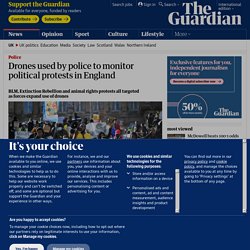
Police also used drones in 2020 at animal rights protests, Extinction Rebellion and anti-HS2 demonstrations, and in one instance, an extreme-right protest. Campaigners say the police’s expanded use of drones is happening with the rules not clear and next to no debate. Police say that is not the case. The campaign group Drone watch used freedom of information requests to ask police forces to detail their use of drones at protests from January to October 2020. The Surrey, Cleveland, Staffordshire, Gloucestershire and West Midlands forces said they had used drones at BLM protests. China’s Surveillance Tech Is a Nightmare for Muslims. Drones, Phones and Automobiles: How to reap the benefits of innovative technology AND foster trust - NewsroomNewsroom. The civilian drone market is taking off.

Drones could revolutionise current services, open up new ones and even improve people’s quality of life, but will consumers have to give up a little privacy to reap these benefits or can good privacy practices help enable innovation in this fast-moving new frontier? An estimate by PwC puts the value of business services using drones at £102bn by 2025 [1].
Another by the Teal Group predicts the global aerial drone market will be £11.27bn by 2025 [2]. Businesses of all kinds can see the competitive advantages that drones might give them – they can deliver packages, conduct surveys, produce accurate maps, inspect power lines, monitor rail tracks, patrol perimeter fencing and a lot more. Drones, Phones and Automobiles: How to reap the benefits of innovative technology AND foster trust - NewsroomNewsroom. FTC Workshop Analyzes Privacy Implications of Drones. On October 13, the Federal Trade Commission (FTC) held a workshop on drone privacy and cybersecurity as part of its Fall Technology Series.

Close watchers of the drone privacy debate would recognize the arguments presented at the FTC workshop as reminiscent of the comprehensive and productive debate over drone privacy played out before the National Telecommunications and Information Administration (NTIA) earlier this year. The NTIA process concluded with the release of Best Practices for drone privacy supported by a diverse group of industry members and civil society representatives. Although the FTC’s workshop was in many ways a reprise of the NTIA multi-stakeholder debate, the workshop was notable insofar as the public gained new insights into FTC staff views on drone privacy and cybersecurity. First, we learned that the FTC staff has concerns about drone cybersecurity. Drones, Subjects, and Protecting Both. DENISE HOWELL / internet and technology lawyer. host, This WEEK in LAW.
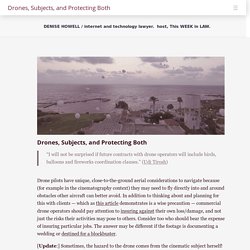
“I will not be surprised if future contracts with drone operators will include birds, balloons and fireworks coordination clauses.” (Udi Tirosh) Drone pilots have unique, close-to-the-ground aerial considerations to navigate because (for example in the cinematography context) they may need to fly directly into and around obstacles other aircraft can better avoid. Hauts-de-Seine: le maire d'Asnières veut des drones de vidéo-surveillance - LCI. LUTTE CONTRE LA DÉLINQUANCE – Manuel Aeschlimann, maire LR d'Asnières (Hauts-de-Seine), veut équiper sa commune en drones de vidéo-surveillance.
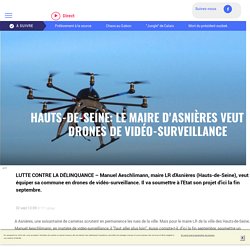
Il va soumettre à l'Etat son projet d'ici la fin septembre. A Asnières, une soixantaine de caméras scrutent en permanence les rues de la ville. The IoT threat to privacy. As the Internet of Things becomes more widespread, consumers must demand better security and privacy protections that don’t leave them vulnerable to corporate surveillance and data breaches.
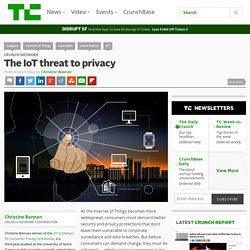
But before consumers can demand change, they must be informed — which requires companies to be more transparent. The most dangerous part of IoT is that consumers are surrendering their privacy, bit by bit, without realizing it, because they are unaware of what data is being collected and how it is being used. As mobile applications, wearables and other Wi-Fi-connected consumer products replace “dumb” devices on the market, consumers will not be able to buy products that don’t have the ability to track them. It is normal for consumers to upgrade their appliances, and it most likely does not occur to them that those new devices will also be monitoring them.
Drones And The Right To Privacy. Submitted by James E.
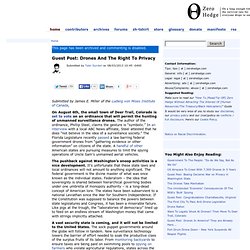
Miller of the Ludwig von Mises Institute of Canada, On August 6th, the small town of Deer Trail, Colorado is set to vote on an ordinance that will permit the hunting of unmanned surveillance drones. The author of the ordinance, Phillip Steel, claims the gesture is “symbolic.” In an interview with a local ABC News affiliate, Steel attested that he does “not believe in the idea of a surveillance society.” The Florida Legislature recently passed a law barring federal government drones from “gathering evidence or other information” on citizens of the state.
The pushback against Washington’s snoop activities is a nice development. A vast security state is coming, and it will not be limited to the United States. All the while, the political class gives an assurance that the technological innovation will not be abused. One has to be either lying or painfully ignorant to believe government will not abuse surveillance drones. But is there really a right to privacy? Domestic surveillance drone bans are sweeping the nation. Courtesy of Draganfly Innovations Inc In the past year, the American public has begun to pay more and more attention to the issue of domestic surveillance drones.
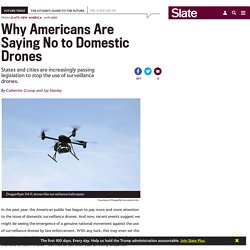
And now, recent events suggest we might be seeing the emergence of a genuine national movement against the use of surveillance drones by law enforcement. With any luck, this may even set the stage for a wider dialogue about the increasingly intrusive technologies that are intended to catch crooks—but that all too often cast an overly broad net. Police use drones to spot grow-ops in Halton Region. TORONTO - Look up, look way up.
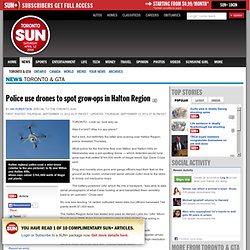
Was it a bird? Was it a spy plane? Not a bird, but definitely the latter was soaring over Halton Region, police revealed Thursday. What police for the first time flew over Milton and Halton Hills on Wednesday was a pot-spotting drone — which detected secret rural grow-ops that netted $744,000 worth of illegal weed, Sgt. Dave Cross said. IAPP Piece Outlines Drone Privacy State-of-Play. Over the next five years in the United States, thousands of drones are expected to be deployed for an array of commercial and governmental purposes.
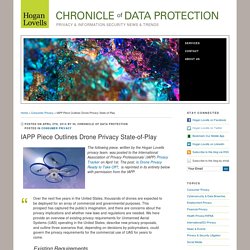
This prospect has captured the public’s imagination, and there are concerns about the privacy implications and whether new laws and regulations are needed. We here provide an overview of existing privacy requirements for Unmanned Aerial Systems (UAS) operating in the United States, describe new privacy proposals, and outline three scenarios that, depending on decisions by policymakers, could govern the privacy requirements for the commercial use of UAS for years to come.Existing RequirementsUAS operators already must comply with a host of common law, state and federal privacy requirements.Most states recognize the tort of “intrusion upon seclusion,” which can impose liability on those who intentionally intrude upon the seclusion of others in a manner that would be highly offensive to a reasonable person.
Government’s Domestic Use of Drones Poses Privacy Questions for Congress and the Courts. By David Young, CIPP/US Mention the use of drones—or unmanned aircraft systems (UAS)—and most Americans will likely think of either military uses in remote areas of Afghanistan or the potential for commercial drone use, such as Amazon package delivery. A great deal of attention has recently been focused on the latter, because the Federal Aviation Administration (FAA) has named test sites to research issues that will arise when commercial domestic uses of UAS are authorized. There has been substantial discussion that this process should also include consideration of privacy issues. But often overlooked is the fact that the federal government has already been using drones for nonmilitary, domestic purposes, and privacy questions have already emerged.
Organizations such as the ACLU and the Electronic Frontier Foundation (EFF) have been vocal in raising privacy concerns relating to these uses. » Police investigating reports of peeping drones spying inside NH homes. » Amazon.com Drones Raise Red Flags Regarding Privacy Rights. Maxwell Abbot writes: …. In an online announcement, Amazon released some details of its “Prime Air” program which will use small drones to deliver packages within 30 minutes of an order. Bezos stated in an interview with 60 Minutes that Amazon was now focusing on getting approval for the project from the Federal Aviation Administration.
He hopes to have approval from the FAA “as early as sometime in 2015.” Drones And The Right To Privacy. How to prevent drones from coming in your backyard? #privacy. At the Drone World Expo held in San Jose, California on 17-18 November, a number of experts got together to discuss the threat to citizens’ privacy which the spread of unmanned aerial vehicles may potentially represent. Drones continue to hit the headlines. In late November Amazon unveiled new information about its Prime Air programme – basically a plan to use unmanned aerial vehicles to deliver packages in under thirty minutes. Drones and Privacy: A Looming Threat. UNMANNED aircraft, otherwise known as drones, are becoming common.
Many are familiar with America’s use of armed drones in Pakistan, Yemen and elsewhere, but drones are increasingly being used by other parts of the government, as well as by companies and individuals. Drones can be far cheaper to operate than anything that requires an on-board pilot, and they are handy for making maps and taking pictures and videos. The FBI uses a small fleet of drones for law-enforcement surveillance. Customs and Border Patrol uses them to monitor the American border with Mexico (though the programme was recently found to be ineffective and expensive). Commercial drones are now regularly used for real-estate photography and to monitor oil and gas pipelines, among many other applications. Privacy obligations and legal risks of drones. Why Drones Could End up Being Good for Privacy Law
On the front page of the Los Angeles Times this weekend was a story about local police calling in military drones -- in this case, the Predator B -- to help apprehend civilians. Mark my words, this is just the beginning. Drones are simply too effective, too cost efficient, for police, firefighters, and even the private sector to ignore. Imagine what drones would do for the lucrative paparazzi industry, for instance, especially coupled with commercially available facial recognition technology. Ten Myths About Drones Unmanned aerial vehicles (“UAVs”), often called “drones,” are coming to American skies. In February, President Obama signed a law that requires the Federal Aviation Administration to pave the way for public agencies and, eventually, private companies, to fly drones within the United States. The Backlash Against Drones. Drones trigger privacy and liability risks? Student Tweets Entire History of US Drone Strikes.
How long would it take to tweet the entire history of US drone strikes one by one? Josh Begley, a graduate student at New York University, thought he would only need 10 minutes. Cameras on drone aircraft trigger calls for legislation. Like a Swarm of Lethal Bugs: The Most Terrifying Drone Video Yet - Conor Friedersdorf. An Air Force simulation says researchers are at work on killer robots so tiny that a group of them could blend into a cityscape. Science writer John Horgan's feature on the many ways drones will be used in coming years is interesting throughout, and terrifying in the passage where he describes an effort to build micro-drones that are, as the U.S.
Air Force describes them, "Unobtrusive, pervasive, and lethal. " Air Force officials declined a request to observe flight tests at a "micro-aviary" they've built, he reported, but they did let him see a video dramatization "starring micro-UAVs that resemble winged, multi-legged bugs. The drones swarm through alleys, crawl across windowsills, and perch on power lines. One of them sneaks up on a scowling man holding a gun and shoots him in the head.
" Drones increasingly used for surveillance in U.S. Iran's Photoshop FAIL: 'New drone' actually Japanese university bird. High performance access to file storage. Privacy w/ Drones, Google Glass, and other tech. Drone / privacy.